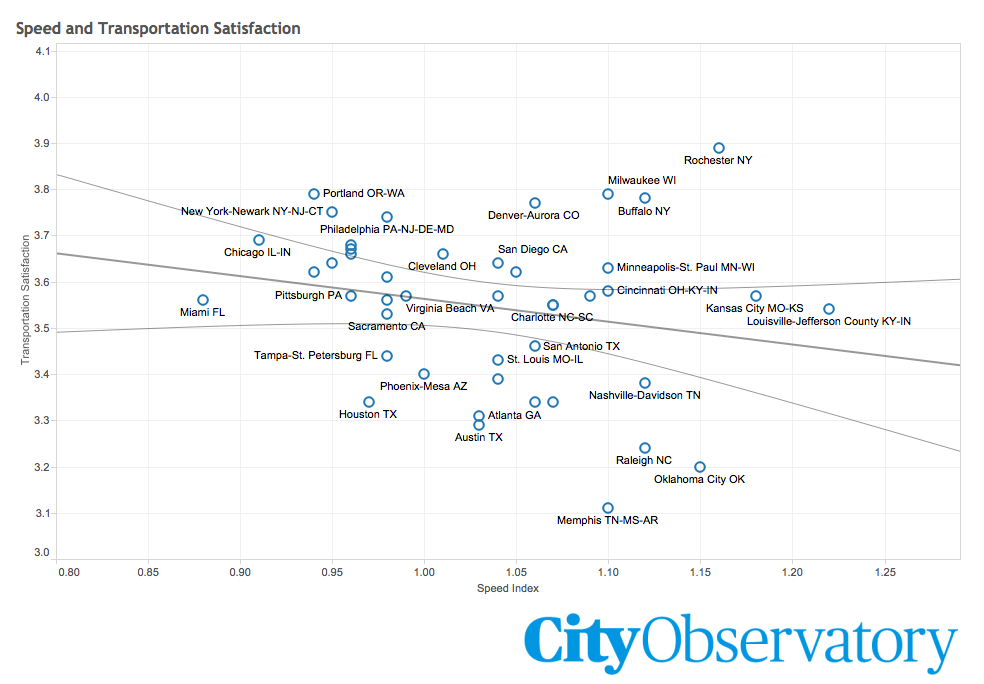What City Observatory did this week
1. Are restaurants dying and taking city economies with them? In a column at Governing, Alan Ehrenhalt raises the alarm that a city economic revival predicated on what he calls “cafe urbanism” is at risk if there’s a collapse in the restaurant sector. Apparently, a number of restaurants in his local Virginia suburb have failed. We look at the national data on restaurants and find that overall, they’re still increasing robustly. In fact, Americans now spend more on food consumed outside the home than they do on groceries. This sector of the economy appears to be doing quite well, at least so far.
2. Affordability beyond the median. The standard yardstick for judging housing affordability is to look at the median level of rents or home prices. As we all remember from statistics, the median is the observation in the middle of the distribution. And while for many purposes, it’s a reliable indicator of typical prices, in some neighborhoods, particularly those with a mix of expensive and cheap housing, the median is actually a weak indicator of affordability. We illustrate with some real world examples how this problem arises, and discuss how to look past the median to better understand neighborhood affordability.
3. How fast are America’s metropolitan areas? If often seems like transportation policy is obsessed with how fast we move. But which metropolitan areas have the fastest travel speeds? Using data from the US DOT’s national transportation survey, and adjusting for typical trip lengths, the University of California’s Victor Couture and co-authors have estimated the average speed of travel in each of the nation’s largest metros. We have the complete ranking: Louisville tops the list, traveling on average 22 percent faster than the typical metro area; while Miami travels the most slowly, about 12 percent slower.
4. Going faster doesn’t make us happier. We combined Victor Couture’s estimates of the relative speed of travel in different metropolitan areas, with survey data on the level of satisfaction local residents report in their transportation system. We found that places with faster travel times didn’t have higher levels of satisfaction. What they did have, however, was longer trips, as measured by vehicle miles traveled (VMT) per person per day. Simply put: faster speeds are correlated with more driving. And interestingly, VMT has a strong negative correlation with satisfaction with the transportation system. People who live in metros with the highest levels of VMT per capita are generally the least satisfied with their transportation systems.

Must read
1. The Trump Budget and Transit. The Trump Administration’s budget for the coming fiscal year would effectively wipe out funding for new transit projects under the New Starts and Small Starts programs that have been the linchpin for funding most of the nation’s rail transit, bus rapid transit and streetcar projects. Yonah Freemark lists the projects now in the pipeline that are in jeopardy. Of course, Congress will have to agree to these cuts, but its an ominous sign from the new administration. Further bad news for cities: big cuts at the Department of Housing and Urban Development, including zeroing out the community development block grant program which is a major funder for neighborhood redevelopment and housing improvement.
2. Mini-Ubers are blooming in Austin. Last year, Lyft and Uber both pulled out of Austin after voters there turned down an initiative that would have exempted transportation network companies from the city’s existing driver finger-printing requirements and other regulations. At the time, we wrote that the city should view this as an opportunity to encourage the growth of home-grown alternatives. “Let a thousand Uber’s bloom,” we said. And according to a new article in CNNTech, that’s just what seems to be happening. As we suggested, it was probably a bad idea to pull out of a city full of independent minded customers, smart programmers and serial entrepreneurs.
3. The run down on Uber. Uber has been in the news so much lately that its hard to keep track of what’s being said. For a great synopsis of all of these events, read CityLab’s run-down, with copious links to media coverage. Laura Bliss has covered the waterfront, from the company’s financial problems to charges of sexual harassment.
4. Are tiny houses an answer to homelessness? In Portland, Multnomah County leaders have proposed an innovative program to buy tiny houses–those super compact, space efficient living units–and give them to local homeowners, provided they place them in their yards and allow an otherwise homeless family to live in them for at least five years. The county calculates that housing people in tiny houses is less expensive than the cost of shelters, and new units could be put in place much more rapidly than with new construction. Already, the city of Portland has permitted one innovative project to develop a cluster of tiny houses to house the homeless.

New research
The importance of economic integration to academic success. A new paper in the Journal of Urban Economies from George Galster and three co-authors looks at the results of a natural experiment in Denver. (Hat tip to the Chicago Policy Review for flagging this work). The Denver Housing Authority had a program that quasi-randomly assigned eligible households to housing in a variety of neighborhoods. Galster and his co-authors looked at data on the school performance of children in these families, and examined the correlations between neighborhood characteristics and educational performance. This avoids the problem of “selection bias” that plagues many studies of such relationships, i.e. that families that move to higher opportunity neighborhoods self-select and may be different in unobservable ways from other families. They find that “neighborhoods having less social vulnerability, higher occupational prestige and lower percentages of African American residents robustly predict superior secondary educational performance.” Its yet more evidence that economically integrated neighborhoods are a key to overcoming the disadvantages of poverty.

